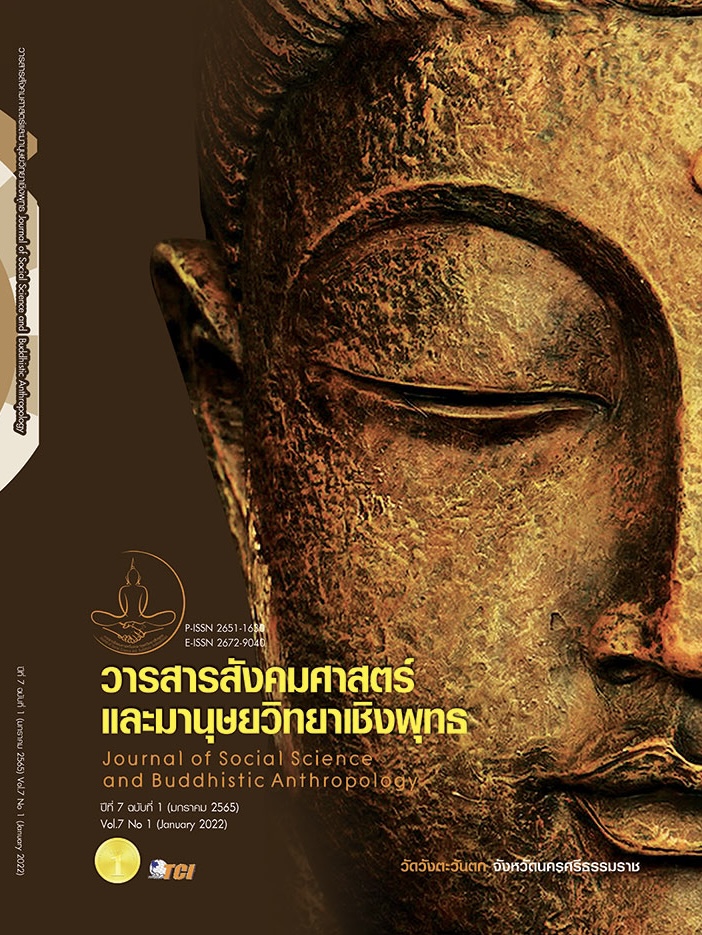COLLABORATIVE TOURISM MANAGEMENT FOR SUSTAINABILITY OF THE PLA-BA COMMUNITY, LOEI PROVINCE
Keywords:
Tourism Management, Collaborative Tourism, Communication for TourismAbstract
The objectives of this research article were to 1) study power and network relations for collaborative tourism. 2) study collaborative tourism management. 3) To study tourism identity, perception of tourism impacts and tourism support. 4) To study communication for collaborative tourism management. This research was qualitative, studied at the Pla-ba community, Loei Province. The data was collected by 1) Document analysis with documents, advertising and public relations media about policy and tourism management in the Pla-ba community. 2) Field study: in-depth Interview 5 people from DASTA Loei Office, TAT Loei Office, Loei Horticulture Research Center, Wimuttisuk Phurua Macadamia Farm, and focus group interview 8 people from local community 3) Non-participant observation by field note. The findings presented that 1) Power and network relations had a mutual relationship and were a result of communication. Network relations were important because made collaboration simply happening. 2) The Pla-ba community was conducted collaborative tourism that focused on stakeholders, they shared resources to achieve objectives. 3) Local community constructed tourism identity by connected with the place, positive perceptions of tourism impacts leading to collaborative willingness and tourism management support. 4) The communication was defined appropriated purpose, strategies, and channel, which achieve the purpose. The communication was an important variable that helped to created collaboration.
References
ดรุณี คำนวณตา และ สุชีพ พิริยสมิทธิ์. (2557). ความร่วมมือในการจัดการท่องเที่ยวในจังหวัดแม่ฮ่องสอน. วารสารวิชาการ คณะบริหารธุรกิจ, 9 (2), 151-169.
ตัวแทนจาก ททท. สำนักงานเลย. (7 พฤษภาคม 2563). การสร้างอำนาจในการจัดการการท่องเที่ยวในชุมชนปลาบ่า. (นางสาวภัทร์ศินี แสนสำแดง, ผู้สัมภาษณ์)
ตัวแทนจาก อพท. สำนักงานพื้นที่เลย. (11 พฤษภาคม 2563). การสร้างเครือข่ายความสัมพันธ์ในการจัดการการท่องเที่ยวในชุมชนปลาบ่า. (นางสาวภัทร์ศินี แสนสำแดง, ผู้สัมภาษณ์)
ตัวแทนจากชมรมส่งเสริมการท่องเที่ยวโดยชุมชนตำบลปลาบ่า. (28 มิถุนายน 2563). การรับรู้ผลกระทบทางการท่องเที่ยวในชุมชนปลาบ่า. (นางสาวภัทร์ศินี แสนสำแดง, ผู้สัมภาษณ์)
ตัวแทนจากผู้อยู่อาศัยในชุมชน. (2 กรกฎาคม 2563). การรับรู้ผลกระทบทางการท่องเที่ยวในชุมชนปลาบ่า. (นางสาวภัทร์ศินี แสนสำแดง, ผู้สัมภาษณ์)
ตัวแทนจากไร่วิมุตติสุขภูเรือ. (1 กรกฎาคม 2563). การสื่อสารเพื่อสร้างความร่วมมือใน การจัดการการท่องเที่ยวในชุมชนปลาบ่า. (นางสาวภัทร์ศินี แสนสำแดง, ผู้สัมภาษณ์)
พิมพ์ลภัส พงศกรรังศิลป์. (2557). การจัดการการท่องเที่ยวชุมชนอย่างยั่งยืน: กรณีศึกษา บ้านโคกไคร จังหวัดพังงา. วารสารวิชาการ Veridian E-Journal ฉบับมนุษยศาสตร์ สังคมศาสตร์ และศิลปะ, 7 (3), 650-665.
วิกานดา พรสกุลวานิช. (2560). สื่อใหม่และการจัดการการสื่อสาร. กรุงเทพมหานคร: สำนักพิมพ์มหาวิทยาลัยธรรมศาสตร์.
องค์การบริหารการพัฒนาพื้นที่พิเศษเพื่อการท่องเที่ยวอย่างยั่งยืน. (2556). เกี่ยวกับเรา. เรียกใช้เมื่อ 15 กันยายน 2562 จาก http://dasta.or.th/th/aboutus
องค์การบริหารการพัฒนาพื้นที่พิเศษเพื่อการท่องเที่ยวอย่างยั่งยืน. (2559). เที่ยวนี้...ที่ไม่เหมือนเดิม. กรุงเทพมหานคร: บริษัท โคคูน แอนด์ โค จำกัด.
อัจฉรา ปัณฑรานุวงศ์. (2556). สถานภาพของการสื่อสารเชิงบูรณาการในองค์กร. ใน รายงานการวิจัย. มหาวิทยาลัยธรรมศาสตร์.
Ap, J. (1992). Residents’ perceptions on tourism impacts. Annals of Tourism Research, 19 (4), 665–690.
Beritelli, P. & Laesser, C. (2011). Power dimensions and influence reputation in tourist destinations: Empirical evidence from a network of actors and stakeholders. Tourism Management, 32 (6), 1299-1309.
Czernek, K. et al. (2017). Trust and formal contracts: complements or substitutes? A study of tourism collaboration in Poland. Journal of Destination Marketing & Management, 6 (4), 318-326.
Denzin, N. & Lincoln, Y. (2018). Handbook of Qualitative Research. California: SAGE.
Fyall, A. et al. (2012). Destination collaboration: Acritical review of the oretical approaches to a multi-dimensional phenomenon. Journal of Destination Marketing Management, 1 (2), 10–26.
Hidalgo, C. & Hernandez, B. (2001). Place attachment: conceptual and empirical questions. Journal of Environmental Psychology, 21 (3), 273-281.
Lin, D. & Simmons, D. (2017). Structured inter-network collaboration: Public participation in tourism planning in Southern China. Tourism Management, 63 (2017), 315-328.
Mihalic, T. (2015). Sustainable–responsible tourism discourse: towards ‘responsustable’ tourism. Journal of Cleaner Production, 111, 461–470.
Proshansky, M. (1978). The city and self-identity. The Annual British Psychological Society Conference. Environment and Behavior, 10, 147–169.
Reed, M. (1997). Power relations and community-based tourism planning. Annals of Tourism Research, 24 (3), 566-591.
Salvatore, R. et al. (2018). Tourism transition in peripheral rural areas: Theories, issues and strategies. Annals of Tourism Research, 68 (2018), 41-51.
Wood, D. & Gray, B. (1991). Toward a Comprehensive Theory of Collaborative. The Journal of Applied Behavioral Science, 27 (2), 139-162.
Downloads
Published
How to Cite
Issue
Section
License
Copyright (c) 2022 Journal of Social Science and Buddhistic Anthropology

This work is licensed under a Creative Commons Attribution-NonCommercial-NoDerivatives 4.0 International License.








